

Atoms. Previous home next Michael Fowler, University of Virginia Early Greek Ideas The first "atomic theorists" we have any record of were two fifth-century BC Greeks, Leucippus of Miletus (a town now in Turkey) and Democritus of Abdera.

Their theories were naturally more philosophical than experimental in origin. The basic idea was that if you could look at matter on smaller and smaller scales (which they of course couldn't) ultimately you would see individual atoms - objects that could not be divided further (that was the definition of atom). This was all pure conjecture, but the physical pictures they described sometimes seem uncannily accurate. …look closely, whenever rays are let in and pour the sun's light through the dark places in houses … you will see many particles there stirred by unseen blows change their course and turn back, driven backwards on their path, now this way, now that, in every direction everywhere.
Galileo Things began to look up with the Renaissance. Newton Quest. 31. Blackbody Radiation. Introduction Newton's laws of motion and universal gravitation, the laws of conservation of energy and momentum, the laws of thermodynamics, and Maxwell's equations for electricity and magnetism were all more or less nearly complete at the end of the Nineteenth Century.

They describe a universe consisting of bodies moving with clockwork predictability on a stage of absolute space and time. They were used to create the machines that launched two waves of industrial revolution — the first one powered by steam and the second one powered by electric current. File:Solvay conference 1927.jpg. Great Experiments of Physics. History of physics. HyperPhysics Concepts. About HyperPhysics Rationale for Development HyperPhysics is an exploration environment for concepts in physics which employs concept maps and other linking strategies to facilitate smooth navigation. For the most part, it is laid out in small segments or "cards", true to its original development in HyperCard.
Important Dates and Discoveries - The Physics of the Universe. Introduction to Physics. Physics is often described as the study of matter and energy.

It is concerned with how matter and energy relate to each other, and how they affect each other over time and through space. Lecturenotes_1_part2.pdf. List of experiments. Minute physics. Minute physics. Modern physics. Classical physics is usually concerned with everyday conditions: speeds much lower than the speed of light, and sizes much greater than that of atoms.
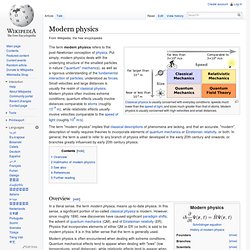
Modern physics is usually concerned with high velocities and small distances. The term modern physics refers to the post-Newtonian conception of physics. Put simply, modern physics deals with the underlying structure of the smallest particles in nature ("quantum" mechanics), as well as a rigorous understanding of the fundamental interaction of particles, understood as forces. Small velocities and large distances is usually the realm of classical physics. Modern physics often involves extreme conditions; quantum effects usually involve distances comparable to atoms (roughly 10−9 m), while relativistic effects usually involve velocities comparable to the speed of light (roughly 108 m/s). Overview[edit] In a literal sense, the term modern physics, means up-to-date physics. Modern Physics: An Historical Overview of the Development of Quantum Mechanics, Quantum Field Theory, Relativity, and Cosmology. This timeline is is a greatly expanded version of that presented in Wikipedia’s article on the history of quantum mechanics, with milestones in the development of Relativity, cosmology, and particle physics also included due to their overlap in attempts to construct a Theory of Everything (TOE).
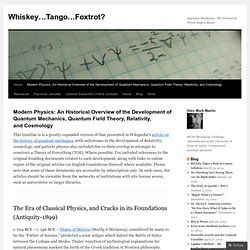
Where possible, I’ve included references to the original founding documents related to each development, along with links to online copies of the original articles (or English translations thereof) where available. Please note that some of these documents are accessible by subscription only. In such cases, the articles should be viewable from the networks of institutions with site license access, such as universities or larger libraries. Modern Physics: Introduction. Quantum Casino - Less Than Zero Chance.
Human thought has led to a variety of remarkable and profound insights.
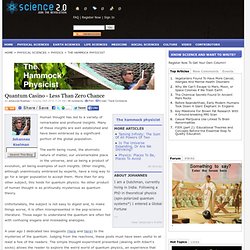
Many of these insights are well established and have been embraced by a significant portion of the global population. The earth being round, the atomistic nature of matter, our unremarkable place in the universe, and us being a product of evolution, all being examples of such insights. Other insights, although unanimously embraced by experts, have a long way to go for a larger population to accept them. More than for any other subject, this holds for quantum physics. No other product of human thought is as profoundly mysterious as quantum theory. Unfortunately, the subject is not easy to digest and, to make things worse, it is often misrepresented in the pop-science literature. A year ago I dedicated two blogposts (here and here) to the mysteries of the quantum.
Yet, I feel one question remained insufficiently discussed in my earlier posts. Albert gets curious about the other columns. This drives Albert crazy. Rutherford's Nuclear World: The Story of the Discovery of the Nucleus Rutherford became Cavendish Professor and director of the Cavendish Laboratory in 1919, following the footsteps of J.J.
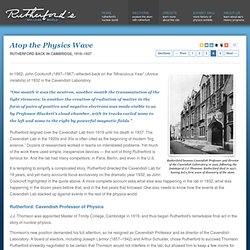
Thomson. Science's 10 most beautiful experiments with dates. Science's 10 most beautiful experiments with dates. Scientist Neil DeGrasse Tyson Patiently Explains How Science Works To GOP Businessman On Real Time. The Long Road to Maxwell’s Equations. Should you wish to pay homage to the great physicist James Clerk Maxwell, you wouldn’t lack for locales in which to do it.
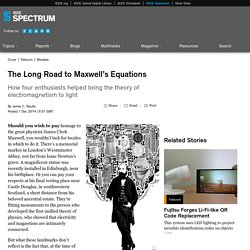
There’s a memorial marker in London’s Westminster Abbey, not far from Isaac Newton’s grave. A magnificent statue was recently installed in Edinburgh, near his birthplace. Or you can pay your respects at his final resting place near Castle Douglas, in southwestern Scotland, a short distance from his beloved ancestral estate. The Physics Hypertextbook. Understanding quantum tunnelling. The recent claim from Stark Industries Lockeed Martin that a compact fusion reactor could be built soon is, if true, a breakthrough in engineering rather than basic physics.
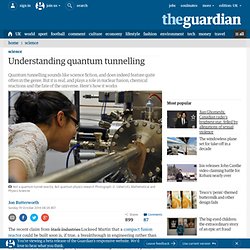
The basic physics of fusion has been known for some time, and a key element of understanding it is quantum tunnelling. Nuclei have a positive electric charge, and since like charges repel, there is an energy barrier to be overcome. Once the barrier is overcome, the strong nuclear force takes over¹. One way of overcoming the barrier is ‘quantum tunnelling’, and, weird though it sounds (and indeed is) the maths and physics of that is quite well understood. Here’s how it works. The first thing to understand is that quantum particles – and all particles are quantum particles once you are as small as an atom – behave, in some ways, like waves as they travel around. Waves and exponentials Next, we need to look at the mathematics behind waves. The most common wave in this context is a sine wave. Y = sin(x) = x - x³/3!
Www.colorado.edu/physics/phys3220/phys3220_fa08/notes/notes/lecturenotes_1_part2.pdf.